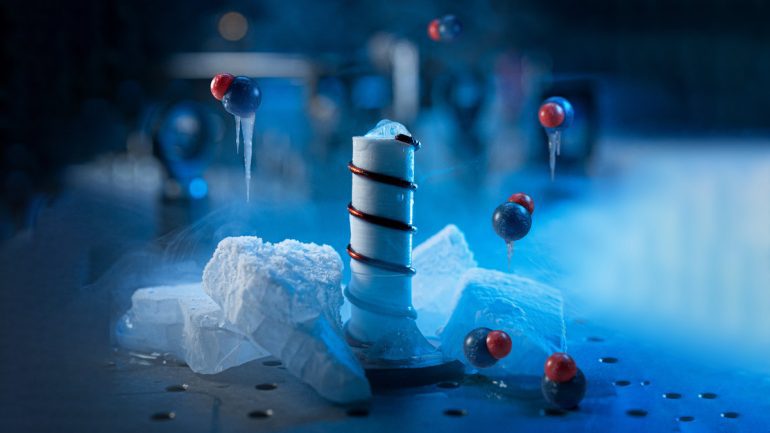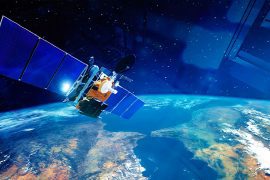A new method for cooling gases from polar molecules to near absolute zero paves the way for studying quantum effects of exotic forms of matter
Researchers at the Max Planck Institute for Quantum Optics have developed a new cooling technique for molecular gases that makes it possible to cool polar molecules down to a few nanokelvins. The team in Garching’s trick to overcome this obstacle is based on a rotating microwave field. It helps stabilize collisions between molecules during cooling by providing an energetic protective screen. In this way the Max Planck researchers succeeded in cooling a gas made up of sodium-potassium molecules to 21 billionths of absolute zero. He has set a new low temperature record. With the new technology, many forms of quantum matter that were previously experimentally inaccessible could be generated and researched in the future.
© MPQ
A deep insight into the main vacuum chamber of the NaK molecular experiment. In between, four high-voltage copper wires are carried into an ultra-high-vacuum glass cuvette, in which ultra-cold polar molecules are generated.
© MPQ
When a highly dilute gas is cooled to extremely low temperatures, strange properties become apparent. Some gases form what is known as a Bose-Einstein condensate – a type of substance in which all atoms move together. Another example is supersolidity: a state where matter behaves like a viscous fluid with a periodic structure. Physicists expect particularly diverse and manifest forms of quantum matter when cooling gases containing polar molecules. They are characterized by uneven electric charge distribution. Unlike free atoms, they can move, vibrate and attract or repel each other. However, it is difficult to cool molecular gases to ultra-low temperatures.
A team of researchers from the Max Planck Institute for Quantum Optics in Garching has now created a simple and effective way to overcome this obstacle. It is based on the rotating field of the microwave.
a cup of coffee
For their experiments, the researchers used a gas composed of sodium-potassium molecules (NaK), confined in an optical trap by laser light. To cool the gas, the team used a process that has long been tried and tested for cooling unbound atoms: so-called evaporative cooling. “This method works on the same principle as a cup of hot coffee,” says Shin-Yu Luo, head of the Laboratory for Ultracold Polar Molecules in the Department of Quantum Many-Body Systems at the Max Planck Institute for Quantum Optics. Water molecules in coffee constantly collide and exchange part of their kinetic energy. If two particularly high-energy molecules collide, one of them may be fast enough to escape the coffee – it pops out of the cup. The second molecule has less energy left. In this way the coffee cools slowly. Similarly, a gas can be cooled down to a few nanokelvins—a billionth of a degree from absolute zero—at minus 273.15 °C.
However: “If the gas consists of molecules, these must be additionally stabilized at very low temperatures,” Luo says. The reason for this lies in the more complex structure of molecules than unbound atoms. This makes it difficult to control their movements during a confrontation. Molecules can become trapped in each other when they collide. In the case of polar molecules, this is also the case: “They behave like tiny magnets and – as such – can cake together, meaning they are lost to experimentation,” says Shin-Yu Luo’s team. One researcher Andreas Schindewolf explains. , These difficulties have proved to be a major obstacle to research in recent years.
Microwaves keep molecules at a distance
To overcome the obstacle, the Garching researchers used a trick: the additional use of a specially formulated electromagnetic field, which acts as an energetic shield for the molecules and keeps them from being held together and colliding. stops. “We created this energy screen using a strong, rotating microwave field,” explains Andreas Schindewolf. “The field causes the molecules to spin at a higher frequency.” If two molecules come too close to each other, they can exchange kinetic energy – but at the same time they align themselves in such a way that they repel each other and move quickly away from each other again.
To create a microwave field with the necessary properties, the researchers placed a helical antenna under an optical trap containing a gas composed of sodium-potassium molecules. As Shin-Yu Luo reports, “the rate at which the molecules interconnected was reduced by more than an order of magnitude.” In addition, under the influence of the field, a strong and far-reaching electrical interaction developed between the molecules. “As a result, they collide much more often than the rotating microwave field—about 500 times per molecule on average,” says the physicist. “It was enough to cool the gas to almost absolute zero using the evaporation effect.”
a new low temperature record
© MPQ
Image of a sodium laser system generating yellow light for laser cooling and imaging of sodium atoms.
© MPQ
After only a third of a second, the temperature had reached about 21 nanokelvins – well below the critical “Fermi temperature”. This marks the extent to which quantum effects determine the behavior of a gas – and strange phenomena become noticeable. “The temperature we’ve reached is the lowest we’ve ever seen in a gas made up of polar molecules,” says Luo happily. And the Max Planck researcher is convinced that by technically refining the experimental setup, they can reach even very low temperatures.
The results could have far-reaching consequences for research into quantum effects and quantum matter. “Since the new cooling technique is so simple that it can be integrated into most experimental setups even with ultracold polar molecules, this method should soon find wide application – and contribute to many new findings,” said department director Emmanuel Bloch says. Quantum many body systems. “Because cooling by the microwave field not only opens up a range of new investigations into strange states of matter, such as superfluidity or supersolidity,” Bloch says. “It could also be useful in quantum technologies.” For example in quantum computers, where data can probably be stored using ultracold molecules. “These are really exciting times for researchers who deal with ultracold polar molecules,” I Xin-Yu Luo says happily.

Internet fan. Alcohol expert. Beer ninja. Organizer. Certified tv specialist. Explorer. Social media nerd.








